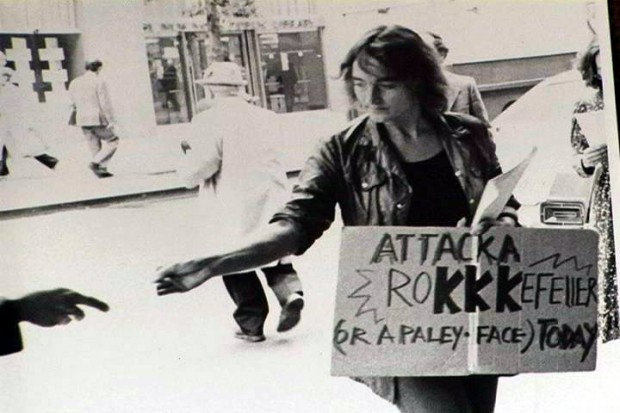
Lucy Lippard in 1976. Alongside her writing and curating, Lippard’s a well-known activist, participating with the Art Workers’ Coalition and WAC (Women’s Action Coalition), among others.
For the best straight talk on art criticism, look back 50 years. In her 1966 essay “After a Fashion: The Group Show,” art critic and curator Lucy Lippard wrote an unintentional manifesto on what makes a good art critic. Experience counts more than theory, reviews need not be descriptive, critics should talk to artists, and being partisan is part of the job. Amen.
I’ve transcribed an excerpt from the essay—though if you want the full thing, you’ll need to hit up JSTOR. “After a Fashion” just proves that 50 years later, we’ve still got a ways to go.
The idea that the critic should have nothing in common with the artist is one promulgated by art historians more accustomed to dealing with artists who have been dead for some time. A great majority of the fundamental ideas presented by the new critics comes from the artist, from their works and from constant dialogues. If the critics spend more time classifying, analyzing, justifying these ideas than the painters whose task is to provide them in visual form, that is not a matter of exerting influence….
All major critics have been partisan. Esthetic experience can only be so objective. It should hardly be surprising that the more esthetically attracted one is to a work or type of work the more one seeks to explore, hopefully not to rationalize, this attraction. Without some strong commitment, criticism becomes the pedantic, review-oriented, nit-picking, wage-earning esoterica to which book and art reviewers often succumb.
The new criticism is opposed to the “review syndrome” that has so plagued contemporary art writing with minutiae, poetry, fanciful journalism, social commentary and explanations based on a vague premise of Zeitgeist. It is founded on the experience of looking at art objects and thinking about their achievements and effects. Ideally the conclusions drawn are readable, but not necessarily easy to read. Like the art it takes its lead from, much recent criticism does not aim to entertain or explain. (p. 624 – 625)
A couple of notes we here at AFC added to this text:
1. The idea that the art critic should have nothing in common with the artist may still be promulgated by the art historian but now that job lies more with reporters, who live and die by the belief that separation creates needed objectivity. The most egregious example of this objectivity has to come from writing about the art auctions; writers report on multi-million dollar sales, without mentioning the controversies and problems of the secondary market. On the other hand, there’s been no shortage of subjectivity when it comes writing about this year’s Whitney Biennial. Why such uniformity, why such a lack of diversity? It should be more than okay to have a point of view, but there’s still so few of us who come out waving the partisan flag.
2. Criticism often aims to entertain, hence the rise of superstar critics such as Robert Hughes and Jerry Saltz. To some extent, we’re all guilty of this—how many of us who wrote about George W. Bush’s paintings had anything substantial to say? Only Greg Allen.
Writing in an entertaining way helps art critics reach a wider audience and if nothing else, it helps you to sound like a human (not an art-theory robot). But entertainment has given rise to a whole bunch of ***shudder*** listicles. Some listicles can be done quite right, though, like Sarah Thornton’s Top 10 Reasons NOT to Write About the Art Market.
3. That criticism should be “founded on the experience of looking at art objects and thinking about their achievements and effects” is a great start, but it still remains a formalist exercise if that doesn’t lead to talking about how that work relates to real, lived concerns outside of the gallery. Lippard doesn’t get into that much in this early essay, but it’s certainly something she picked up on throughout her life with activist-oriented work, and in Undermining, her most recent book on the politics of land-use in the American Southwest.
Lucy Lippard, “After a Fashion: The Group Show,” The Hudson Review, Vol. 19, No. 4 (Winter 1966 – 1967), pp. 620 – 626.


{ 1 comment }
I tried commenting earlier, but seem to have entered some sort of weird facebook comment suck rather than the AFC comment window. Trying again:
The George Bush paintings are to today’s artworld what Bill T. Jones’s “Still/Here” was to the artworld of the 1990s – rather than “victim art” however, Bush’s paintings (and perhaps, to some degree, the secondary markets as well) are “culprit art” – objects, like “Still/Here” that are overwhelmed by the real world drama of the players. Nice to see you all grappling with this publicly. I’d point your readers to Maurice Berger’s essay collection, The Crisis of Criticism; the issues have changed, but the issue – the role of the critic – hasn’t.
Comments on this entry are closed.